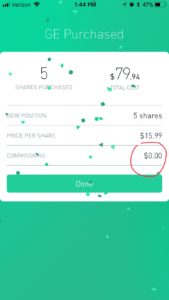I finally made the commission-free plunge. If you’re a small investor like me, you’ve experienced the drawbacks of transaction costs, even on a “discount” trading platform. For example, TDAmeritrade charges me $7 to buy/sell shares of stocks, ETFs, and mutual funds.
If I were buying 100 shares of Apple, that cost might be considered negligible at about nine-hundredths of a percent. But I have to earn $14 from an investment just to break even! Motley Fool literature suggests keeping transaction costs below 2%. That means making a minimum $700 purchase (about 4 shares of Apple) to make the $14 round trip at 2%.
Enter Robinhood. Ever heard of Robinhood? Not the book… the trading platform? Neither had I… that is until this past 6-8 months.
I first heard of Robinhood from a YouTuber named Ryan Scribner. Initially, I was dismissive. Too good to be true, right? Then I started watching more of Ryan’s videos. (I am studying good niche channels for ideas on my own channel.)
The more I heard Ryan mention Robinhood, the more legit it seemed. And each time he talks about Robinhood, he seems more certain of the service. So I started doing my own digging.
To good to be true?
I did learn at Investor Junkie that Robinhood does indeed offer free trades. At first, there was only a mobile app, but now investors can log in on a desktop using the website.
So it’s geared toward Millennials who use mobile technology. As near as I can tell, using the online platform is in beta version only, but may require signing up for Robinhood Gold membership. So for now, the only investments available for free trading are equities and options using the app.
How do they make money?
With “freemium” services, there is no guarantee that they will be around in a year. Others (e.g., Zecco, TradeKing) have attempted freemium trading services and closed. But with venture capitalists like Google Venture backing Robinhood, they appear authentic and credible. Offering premium levels like Robinhood Gold for those who require analysis will generate revenue.
But discount brokerages like Robinhood also earn interest on uninvested funds that are not currently invested. They also earn interest from margin accounts. A margin account is when an investor uses the brokerage’s money to invest in more shares. So investors who trade on margin pay the brokerage interest for the use of that money.

With enough streams of revenue for Robinhood to survive, I gave the app a try with $100. To the left was my first commission free trade! (5 shares of GE…) If you can sign up for Facebook, you can sign up for Robinhood. It’s that easy.
They will ask for your address and social security number, so they can mail you 1099 statements for tax purposes. Naturally, I also had to provide my bank information to transfer the $100.
Although transfer can actually take a few business days to occur, Robinhood gave me instant trading power with the $100. With other discount brokers, I would have waited until I had enough in my account to buy about 25 shares of GE. Then there would be the commission fee of $7.
With Robinhood, you can take full advantage of dollar-cost averaging by investing more frequently.
In the near future, I will be reviewing another free investing platform called M1 Finance.
Are you a small investor who would like to hear more about getting started investing? Sign up below to let me know. I’m in the process of creating a YouTube channel, and possibly a podcast, that talks about personal finance topics not taught in schools.